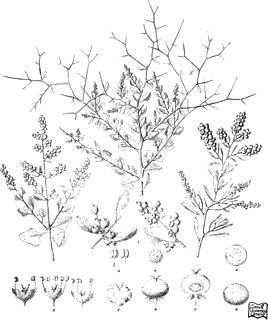
Hakea scoparia is a species of flowering plant in the family Proteaceae and is endemic to the south-west of Western Australia where it grows in shrubland. It is a shrub with ascending branches, terete leaves and clusters of cream to pinkish flowers in leaf axils from June to September.

Melaleuca styphelioides, known as the prickly-leaved paperbark or prickly paperbark, is a plant native to eastern Australia. It is a tree with spongy bark, prickly leaves and spikes of creamy-white flowers.

Persoonia pinifolia, commonly known as pine-leaved geebung or as mambara in the Cadigal language, is a plant in the family Proteaceae and is endemic to the Sydney region of New South Wales. It is an upright, woody shrub with soft, pine-like foliage and long, terminal racemes of small yellow flowers in late winter to summer.

Cuttsia viburnea is a shrub or bushy tree which has toothed leaves and panicles of white flowers, and that is endemic to eastern Australia. It is sometimes called silver-leaved cuttsia, and confusingly also native elderberry, honey bush or native hydrangea. C. viburnea is the only species assigned to the genus Cuttsia.

Trochocarpa montana, the mountain tree heath, is an Australian shrub or small tree. It occurs at high altitude from the Barrington Tops to the Dorrigo region of northern New South Wales.

Eidothea zoexylocarya is a species of tall rainforest trees endemic to north-eastern Queensland, Australia and constituting part of the plant family Proteaceae. In European–Australian science, these trees were only recognised in recent decades, first from the slopes of Mount Bartle Frere, the Queensland mountain which reaches the highest altitude. In 1995, scientific descriptions of the trees, as this genus and type species, were published for the first time by Andrew W. Douglas and Bernie Hyland. The species name refers to the almost identical fossil fruit Xylocaryon lockiiF.Muell., from Ballarat, southern Australia, still extant in this north-eastern Australian species.

Monotoca scoparia, commonly known as prickly broom heath, is a widespread native species across south-eastern Australia. Monotoca scoparia was formerly in the family Epacridaceae but now belongs to the family Ericaceae. Monotoca is an endemic Australian genus with 17 described species occurring in all states.

Persoonia isophylla is a plant in the family Proteaceae and is endemic to New South Wales. It is an erect or spreading shrub with soft, pine-like leaves and groups of cylindrical yellow flowers. It is similar to P. pinifolia but the flowers of that species have small leaves at their base, where the flowers of P. isophylla have full-sized leaves at their base. The two species sometimes grow together but hybrids between them are rare.

Elaeocarpus costatus is a species of flowering plant in the family Elaeocarpaceae and is endemic to Lord Howe Island. It is a tree with lance-shaped to elliptic leaves with wavy-toothed edges, flowers in groups of eight to ten, and blue fruit.

Acacia obliquinervia, known colloquially as mountain hickory or mountain hickory wattle, is a species of Acacia that is endemic to south eastern Australia.

Persoonia adenantha is a plant in the family Proteaceae and is endemic to eastern Australia. It is an upright shrub or small tree with smooth, elliptic to lance-shaped leaves and groups of hairy yellow flowers. It has sometimes been confused with P. cornifolia and P. stradbrokensis.

Persoonia filiformis is a species of flowering plant in the family Proteaceae and is endemic to the south-west of Western Australia. It is a small, erect shrub with hairy young branchlets, linear leaves and greenish yellow flowers borne singly or in groups of up to twenty on a rachis up to 30 mm (1.2 in) long.

Hakea lissosperma, commonly known as needle bush and mountain needlewood, is a species of Hakea native to parts of south eastern Australia.

Hakea eyreana, commonly known as straggly corkbark, is a tree in the family Proteacea and is endemic to arid parts of inland Australia. It has needle-shaped leaves, greenish-yellow flowers and oblong to egg-shaped fruit.

Grahamia is a genus of succulent plants in the family Anacampserotaceae which contains six species which show a disjunct distribution, three species being found in northern Argentina, two in Mexico and one in Australia.

Chenopodium spinescens is a species of plant in the family Amaranthaceae, endemic to Australia. It is found in all states and territories of Australia with the exception of Tasmania.

Calandrinia granulifera is an annual herb in the family Montiaceae, and is native to New South Wales, Tasmania, Western Australia, South Australia, and Victoria.

Lysiana subfalcata, common name Northern mistletoe, is a spreading to pendulous hemi-parasitic shrub in the Loranthaceae which occurs in all mainland states of Australia except Victoria.

Hakea rostrata, common name beaked hakea, is a flowering plant in the family Proteaceae, native to South Australia and Victoria.

Anacampseros albidiflora is a species of succulent plant native to the Great Karoo and Little Karoo regions of South Africa.


















